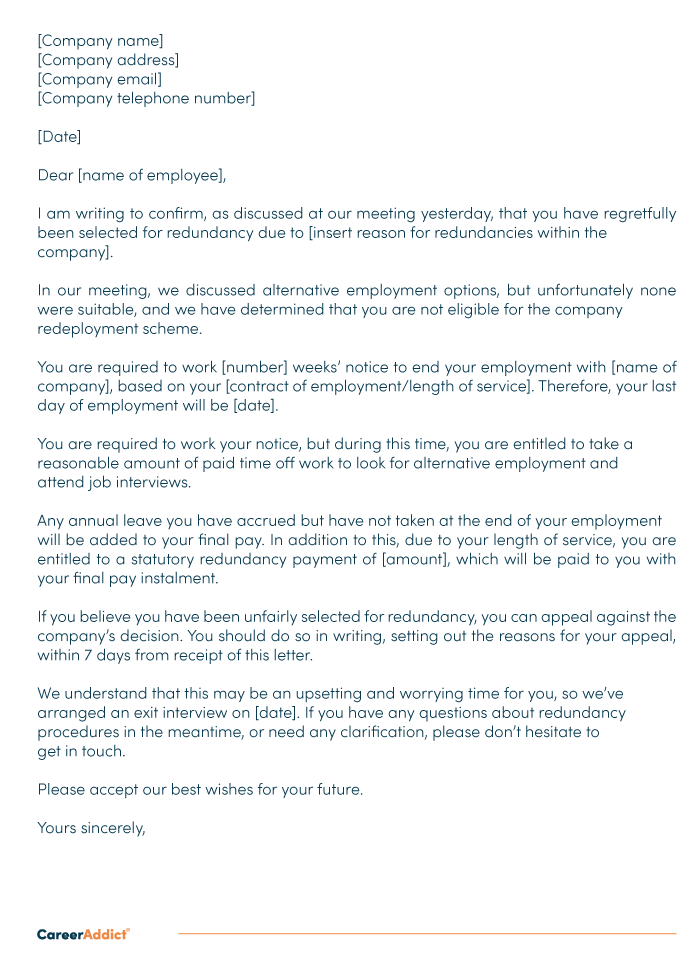How to Handle Redundancy Pay If Company Goes Bust: Key Information for UK Employees
How to Handle Redundancy Pay If Company Goes Bust: Key Information for UK Employees
Blog Article
Examining the Interplay In Between Company Redundancy and Business Versatility for Future Growth
In the dynamic landscape of today's organization globe, the elaborate connection in between firm redundancy and organizational adaptability arises as an essential aspect for continual development and success. Companies frequently deal with the obstacle of striking a fragile equilibrium between preserving a level of redundancy to alleviate threats and cultivating flexibility to react swiftly to the ever-evolving market demands.
Significance of Business Redundancy
Business redundancy is a vital component that boosts business strength and minimizes functional dangers. By including redundancy actions within the business structure, business can better stand up to unanticipated disturbances and fluctuations in the company atmosphere. Redundancy functions as a tactical buffer, permitting firms to adjust and respond efficiently to unexpected difficulties without jeopardizing vital operations.
One key aspect of the relevance of firm redundancy is its function in guaranteeing continuity during times of situation. When confronted with unexpected modifications or emergencies, repetitive systems, resources, or workers can action in to keep vital functions and prevent prevalent disturbances. This continuity not just safeguards the business's credibility and customer depend on however additionally lessens financial losses and functional downtime.

Methods for Business Flexibility

Producing adaptable organizational structures that enable for quick adjustments to market characteristics and consumer demands is necessary for staying competitive in a rapidly advancing atmosphere. By proactively recognizing possible interruptions and chances, organizations can proactively adjust and prosper in an ever-changing organization landscape.
Balancing Redundancy and Adaptability
Attaining a harmonious balance in between functional redundancy and business adaptability is critical in browsing the complexities of a vibrant service atmosphere. Redundancy within a company gives a security net, ensuring connection and stability in procedures. However, an unwanted of redundancy can result in inefficiencies and prevent versatility to changing market conditions. On the various other hand, organizational flexibility enables companies to respond without delay to external interruptions and confiscate new possibilities. Striking the best equilibrium between redundancy and versatility is a fragile process that calls for a deep understanding of the organization's goals, sector dynamics, and danger resistance.
To my review here accomplish this equilibrium, business require to carry out routine analyses of their operations to determine locations where redundancy is needed for threat reduction and where versatility can drive advancement and development. Carrying out versatile structures, promoting a culture of continual understanding and renovation, and urging open interaction throughout all levels of the organization are key strategies to integrate redundancy and flexibility successfully. By straightening these two essential components, firms can position themselves for sustainable growth and success in an ever-changing organization landscape.
Instance Research Studies on Adaptation Success
In analyzing instances of effective organizational adaptation, it ends up being noticeable that the interaction between functional redundancy and flexibility is a specifying consider shaping resilient organizations. One engaging study is that of Netflix. Originally a DVD rental service, Netflix showed exceptional versatility by transitioning right into a streaming system when digitalization disrupted the sector. By tactically purchasing modern technology and material creation, Netflix not just survived yet prospered in a swiftly developing market. An additional standout example is Amazon. Starting as an on the internet bookstore, Amazon continuously adjusted its company version, expanding right into diverse markets such as cloud computer and expert system. This flexibility enabled Amazon to stay in advance of competitors and fulfill changing customer needs. Lastly, Adobe supplies a noteworthy picture of successful adjustment. The company shifted from offering software program licenses to a subscription-based model, making sure recurring income streams and boosted customer engagement. These study emphasize the significance of operational redundancy combined with business adaptability in fostering long-lasting development and competition.
Building Resilience for Future Development
Structure strength for future development needs a calculated alignment of functional procedures with market characteristics and arising patterns. Business need to adapt to changing environments by fostering a society of adaptability, advancement, and constant enhancement. Resilience entails not just getting better from problems but additionally proactively planning for future difficulties. One essential aspect of building resilience is purchasing durable risk management approaches to alleviate prospective disruptions. This consists of situation preparation, branching out supply chains, and establishing backup plans for numerous contingencies (who pays redundancy money).
Furthermore, cultivating solid connections with stakeholders, such as customers, workers, suppliers, and the neighborhood, is important for keeping and weathering uncertainties depend on and assistance during stormy times. Effective communication and openness play a vital function in structure resilience, as they assist promote and align expectations cooperation in browsing uncertainties.
Furthermore, organizations require to focus on learning and advancement campaigns to upskill staff members and equip them with the needed devices to adjust to changing situations. By spending in their labor force, companies can enhance their versatility and dexterity, inevitably reinforcing their resilience for sustainable future growth.
Final Thought

In the vibrant landscape of today's business globe, the detailed connection in between company redundancy and organizational flexibility emerges as a critical factor for continual development and success. Firms typically encounter the challenge of striking a delicate equilibrium in between maintaining a level of redundancy to minimize risks and promoting flexibility to react swiftly to the ever-evolving market demands.To accomplish this equilibrium, companies need to perform regular evaluations of their procedures to recognize locations where redundancy is necessary for danger mitigation and where flexibility can drive technology and growth.In conclusion, the interplay between business redundancy and business flexibility is essential for future growth. Building durability with a mix of redundancy and flexibility will certainly make certain that firms are prepared for the challenges of the future.
Report this page